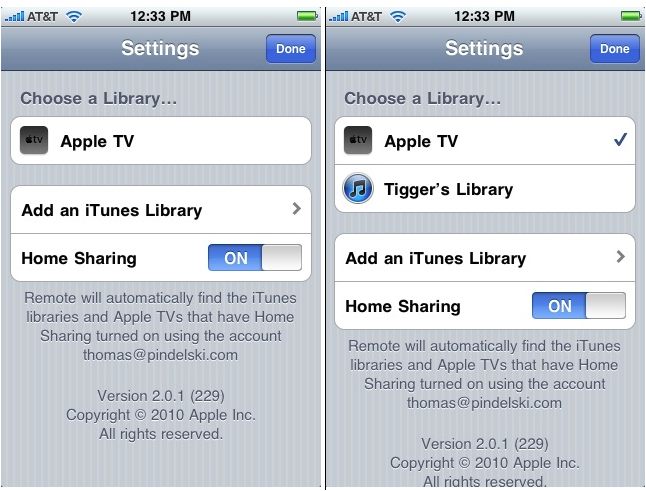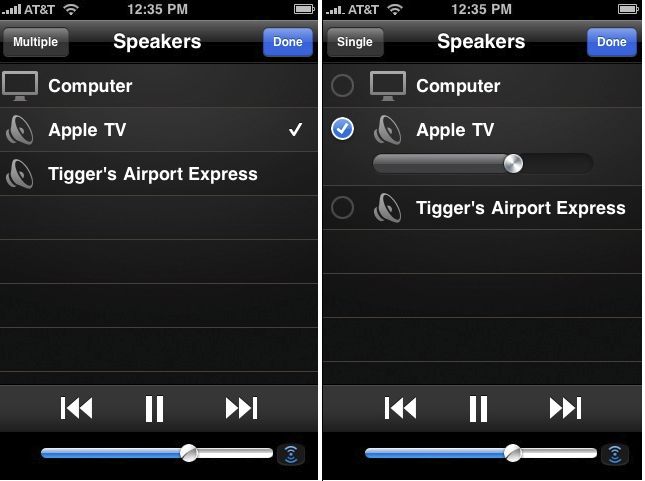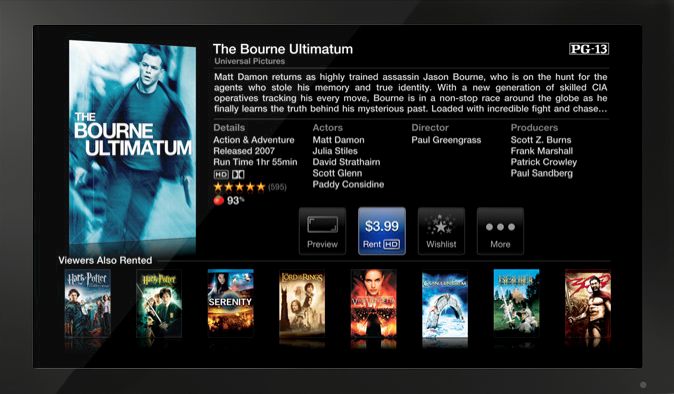AirPlay and more use tests.
Part I appears here.
Here I examine the working of AirPlay, Apple’s update to the use of remote sources and speakers for playing music files.
At this time AirPlay only works for routing sound files, but Steve Jobs has promised that routing of video files will be added before 2011. In Part I, I mentioned that optimal control of the infra red sensor in the AppleTV for use with remotes results from the use of an IR blaster. This small device replaces the AppleTV’s sensor with a much less directional and more sensitive one and works for all IR controlled devices. Simply stated, once you have an IR blaster installed you can pretty much point a remote in any direction and it will work the hardware it is aimed at, however imperfectly. Just ask our 8 year old. I use this one and it’s excellent.
The alternative is to load Remote (free, from the AppStore) on your iPhone, iPod Touch or iPad and use the mobile device to control your AppleTV using wifi, provided you have a wireless network in your home. Thus approach does not require any line of sight to the device you want to control as it uses radio waves.
I downloaded the latest version of Remote and installed it on my iPhone and found that it was very quick to set up and easy to use. The screen shots which follow are from my 3G iPhone.
Fire up Remote and you are asked for the Library you want to use. Mine (“Tigger’s Library”) resides on the HackPro in my home office.

Checking that library as the source, the next two screens ask where you want the sound routed.

In the above, ‘Computer’ refers to the speakers connected to the HackPro. I simply chose ‘AppleTV’ and the music is routed to the speakers connected to our TV. Note the useful provision of a volume control in the second screen, above.
And that’s about it. It’s that simple. This approach allows centralized or distributed storage of music (and, soon, video) files which can now be output to any connected device on the network.
Cover art from your remote server is also fully displayed on the iPhone, thus:

A masterpiece of male chauvinism from Mick and the Boys.
More use tests:
I have now watched several movies using AppleTV as the streaming device. Some were from Netflix, both in SD and HD, and some were purchased from the iTunes store $4.99 or less) also in SD and HD. At no time did any of these exhibit any stuttering or distortion in either video or sound and all loaded and started playing within 30 seconds or less. The AppleTV remains only barely warm to the touch, even after a two hour HD movie transmission and even a child could use the on screen menus. In fact Winston, our 8 year old boy, has proved that to be true. The appearance of the menus using Netflix is identical to that for the iTunes store.
Conclusion:
The AppleTV is unlikely to become the sole device for consuming sound and movies in the home, primarily owing to the dunderheads who run movie studios. They prefer to have a large slice of nothing in royalties than a small slice of something, having convinced themselves that the $0.99 cent pricing of songs in the iTunes Music Store has cheated them. Meanwhile, they conveniently avoid noticing that without iTMS music would be pretty much dead as no one wants to pay $10 for a CD which gathers dust in the home, is hard to access and contains many tracks you do not want. They are now making the same error with movies, on the principle that if your competitor’s candle dims, that brightens yours. I have never known that to be true in any field of human endeavor. You try and explain it to them.
After its previous failures with the AppleTV, Apple seems reluctant to even show the device on its web site and you have to search for the related home page, which can be found here. I can’t even find it on the specifications page, but the power consumption, even when working, does not exceed a couple of watts, which explains why there is no on/off switch.

The elegant and intuitive movie rental page.
However, as a device with a superb user interface which finally avoids the heat, poor performance and price issues of its predecessor, the AppleTV is going to find itself in a lot of Christmas stockings this December at the $99 asking price. I know I will be buying a half dozen or so with just that destination in mind.
In Part III I address the use of a Digital to Analog Converter to convert the AppleTV’s digital/optical sound output to analog for usew with traditional amplifiers and external speakers.
Disclosure: Long AAPL common stock and call options.